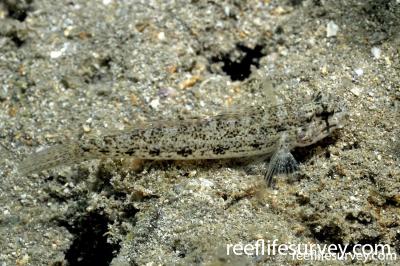Gnatholepis cauerensis
Eyebar goby | Bridled Goby | Cauer Eye-bar Goby | Eyebar Sandgoby | Shoulderspot Goby | Shoulderspot SandgobySimilar Species
Same Genus
Distribution
Tropical Indo-Pacific
Description
Narrow vertical bar through eye to bottom of head. Markings highly variable, but tend to be more distinctly linear down the side compared with those of G. anjerensis (Shoulderspot Sandgoby). Shoulder spot is not diagnostic, varying between individuals, and even between sides of a single individual. Found on sand patches near reefs.
Information
Max Size: 8 cm
Sea Temperature Range: 19.1-31.2°C
Depth: 2-50m
Habitat Generalization Index: 14.3
Also referred to as the SGI (Species Generalisation Index), this describes the habitat niche breadth of the species. Species with values less than 15 are found in a relatively narrow range of reef habitat types (specialists), while those over 25 may be found on most hard substrates within their range (generalists). Learn more here.
Conservation and Rarity
IUCN Status: Least Concern
Occurrence: Common (21.6% of sites)
Occurrence describes how often the species is found on surveys within its distribution. It is calculated as the % of reef sites surveyed by RLS divers across all the ecoregions in which the species has been observed
Abundance: Several (6 per transect)
Abundance is calculated as the average number of individuals recorded per RLS transect, where present.
Edit by: Joe Shields













